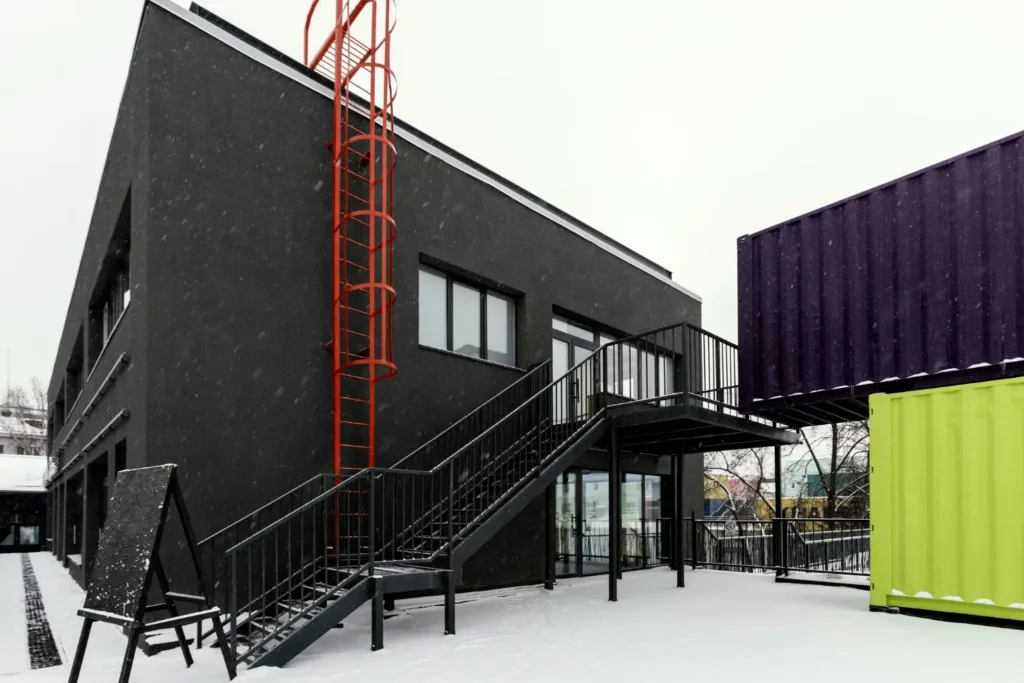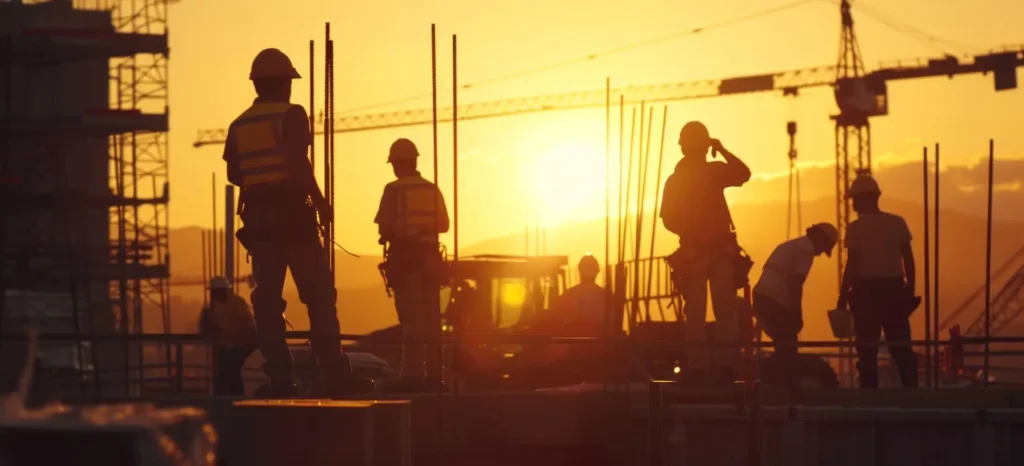Steel Erection for Commercial vs. Residential Buildings: Key Differences and Considerations

Steel erection is a critical phase in construction, requiring precision and expertise. However, weather conditions can significantly impact these projects, influencing everything from safety to timelines and costs. Understanding these impacts is crucial for planning and executing successful steel erection projects.
The Impact of Weather on Steel Erection Projects

Steel erection is a critical phase in construction, requiring precision and expertise. However, weather conditions can significantly impact these projects, influencing everything from safety to timelines and costs. Understanding these impacts is crucial for planning and executing successful steel erection projects.
Case Study: Successful Steel Erection Projects by Leading Steel Erectors
Case Study: Successful Steel Erection Projects by Leading Steel Erectors Steel erection is a critical part of construction that requires precision, expertise, and coordination. Here, we highlight three notable projects executed by leading steel erection companies, showcasing their commitment to quality, safety, and efficiency. 1. Skyline Tower, Chicago, Illinois Project Overview: The Skyline Tower in Chicago, Illinois, is a testament to modern engineering and architectural excellence. Standing tall amidst the city’s iconic skyline, this project required meticulous planning and execution. Challenges: Height and Scale: Erecting steel at such heights demanded advanced equipment and highly skilled personnel. Urban Environment: Working in a bustling urban area required strict adherence to safety protocols and minimal disruption to the surroundings. Erector: Chicago Steel Construction Company Approach: Chicago Steel Construction Company utilized state-of-the-art cranes and rigging systems to handle the steel components, ensuring precision in alignment and bolting. Their team worked in close coordination with other contractors to maintain the project timeline and quality standards. Results: The successful completion of the Skyline Tower has added a stunning new structure to Chicago’s skyline, showcasing their ability to handle complex, large-scale projects in urban settings. 2. Riverfront Convention Center, San Antonio, Texas Project Overview: The Riverfront Convention Center in San Antonio, Texas, required a robust steel framework to support its expansive structure and accommodate large crowds. Challenges: Complex Design: The architectural design included unique angles and expansive open spaces, requiring precise steel fabrication and erection. Environmental Considerations: Proximity to the river necessitated measures to prevent any environmental impact during construction. Erector: Texas Structural Steel Inc. Approach: Texas Structural Steel Inc. employed advanced 3D modeling software to plan the steel erection sequence, ensuring each piece fit perfectly. Environmental protection measures were strictly implemented, minimizing any potential impacts on the river. Results: The convention center now serves as a premier venue in San Antonio, with its structural integrity and aesthetic appeal standing as a testament to their expertise in steel erection. 3. Coastal Office Park, Miami, Florida Project Overview: The Coastal Office Park in Miami, Florida, involved the construction of multiple office buildings designed to withstand the region’s unique environmental challenges. Challenges: Hurricane Resistance: The structures needed to meet stringent building codes to resist hurricane-force winds. Corrosion Prevention: Proximity to the coast required special treatments to prevent steel corrosion. Erector: Florida Steel Erectors Approach: Florida Steel Erectors selected high-strength, corrosion-resistant steel and applied protective coatings to ensure longevity. The steel erection was carefully sequenced to ensure structural stability at every stage, meeting all safety and regulatory requirements. Results: The Coastal Office Park now offers resilient and durable office spaces, contributing to Miami’s economic growth and showcasing their ability to deliver high-quality steel structures in challenging environments. Conclusion These case studies highlight the ability of top steel erection companies to overcome diverse challenges, delivering projects that stand the test of time. Their commitment to safety, precision, and quality ensures that each structure built is a testament to engineering excellence.
Pre-engineered Steel Buildings – Benefit
Pre-engineered steel buildings – benefits Pre-engineered steel buildings have seen more and more popularity in recent years, due to the benefits these provide over their conventional building counterparts. Here are some of the key components that set pre-engineered steel buildings apart from their usual competitors. Strength and durability – Pre-engineered steel buildings are built with galvanized steel, which is much stronger than other materials commonly used in construction. Time and money savings – Building with pre-engineered steel is quick and cost-effective, which can translate into significant savings in time and money over conventional construction methods. Quality and sustainability – The material used to construct the pre-engineered steel frame is specially engineered to resist corrosion and degradation over time, making it extremely durable and reliable. Versatility and design flexibility – The simple design of pre-engineered steel structures makes them easy to integrate into a variety of layouts and configurations for a variety of applications. As such, there is no doubt the benefits of pre-engineered steel buildings, make them a very attractive option for anyone looking for an alternative to more conventional building materials. Building codes require certain levels of insulation to achieve energy efficiency, which can usually be achieved through the use of supplemental insulation applied to the outside of the structure. With these benefits, We at Reliable Steel Erectors chose the erection of pre-engineered metal buildings when it comes to our clients, to guarantee satisfaction and excellent results. Since we pursue the erection of Reliable, Durable, and Safe Steel Buildings. Facebook Twitter LinkedIn
Steel Erection – The Process Overview
Steel Erection Process – Quick Summary Steel Erection is the process of erecting steel materials into structures. Steel erection is a highly-skilled, technical process that requires specialized training and experience to execute successfully. The usual beginnings of the procedure start with the laying down of the foundation using mixed concrete. The foundation is then cured together with the placement of anchor bolts, these serve as guides for the vertical columns Once the structure has been laid out, the vertical columns are then placed one by one onto the anchor bolts and then bolted together to form the structural steel framework of the building, this along with rafters above to form a four point structure. The purlins will then be installed on the rafters to make the roof structure. And horizontal columns will be installed on the vertical columns to complete the steel structure, this comes along with girths in between that also allows gaps for windows or doors. Finishing touches includes adding the metal walls, windows, doors, and insulation for the metal structure depending on the design. Although the process sounds simple through explanation, the procedure needs properly trained individuals to ensure safety when it comes to steel erection. to know more about “The Risks of Steel Erection” read more about it through this link. Facebook Twitter LinkedIn
ColdForm Steel and Red Iron Steel
Cold-Formed Steel and Red Iron Steel Cold steel is a steel structure that we use in the assembly of steel projects. The process of making cold formed steel material goes through a series of several factory machines, unlike Red Iron Steel, Cold Form is smaller in size, making it ideal for residential or private use, but can also be another option commercially. Cold-formed steel members are produced from standard sheets that are produced in C-profiles and other types by turning the steel through a die. No heat is needed to create the shapes, so it is called cold steel. The different types of metals available fall into many different structural and non-structural categories. Red Iron Steel, on the other hand, varies greatly in size and has a red iron color. It is ideally used commercially. Red iron structures are stronger than their traditional steel counterparts, making them a good choice in parts of the country with extreme weather conditions. The integrated I-beam system allows these structures to withstand high winds and heavy snow without damaging the structure or endangering the roofs. In fact, this iron oxide coating gives red steel buildings advantages: Although steel buildings can take decades to start rusting, red paint can prevent corrosion even longer. This feature alone can seal the deal, at least for a long-term investment. Facebook Twitter LinkedIn
Why Choose Steel Erectors
Why choose Steel Erectors Steel Erectors are a type of construction practice that involves the use of heavy steel frames to build structures, such as steel buildings. Such that there are a number of reasons why you might need to use steel erectors in your next construction project. Steel erectors can be used for a variety of different construction projects, and are designed to ensure that they can be applied to a wide variety of environments and situations. What are the benefits of opting for steel erectors? · Workers can avoid the risk of falling from height when erecting steel structures with the use of advance equipment. · Using advanced equipment means that workers can construct large buildings with minimal disruption. · The speed of construction can be increased through the use of modern equipment and practices · Reduced site disruption during construction – The assembly and disassembly of equipment occur outside of the site boundary, which means there are no interruptions to the day-to-day activities. Worker safety is a major consideration when it comes to any construction project, and the use of structural steel erectors can help to reduce this risk significantly. Another main benefit is the erection speed that can be achieved with modern techniques along with the zeroes risks for working of up to 30 meters. The removal of individual pieces with a crane makes the loading of the truck simpler and faster. Loads of material are broken down and removed from the ground or scaffolding and the truck is reloaded fast. The use of a telescopic boom also allows vertical movement with great precision, with practically no weight on the truck. Less time is needed than with traditional on-site assembly methods and in general, there is very little downtime to associated with project execution as the construction time is kept to a minimum due to the speed of project erection. Once the structure is completed, the assembly time is also drastically reduced as very part is ready to use onsite. Some savings can be made by being able to reduce the number of man-hours required to complete the project as well. As such, Steel Erection, when it comes to steel structures, has more benefits than the standard on-site project development. Making it more efficient in terms of speed, cost, and safety. Facebook Twitter LinkedIn
Reliable Steel Erectors: A View into the Insulation We Use
Partner spotlight : A View into the insulation we use The Simple Saver System™ is a high performance insulation and finishing system designed for roof and walls in low rise commercial buildings. Simple Saver System features OSHA compliant Fall ProtectionThe Simple Saver System has been manufactured and marketed through Thermal Design over the past 30 years and has become the #1 specified high R-value insulation system for metal buildings. In addition to superior insulation performance compared to “traditional” methods, the Simple Saver System is a liner system that provides through fall protection anywhere on the roof that it is properly installed, according to Thermal Design’s Instructions. This fall protection is not limited to the leading edge during the installation and roofing process. We invite you to learn more about the concept of the Simple Saver System and why it may be the perfect fit for your next building. Source: https://bit.ly/3d8X3gl Facebook Twitter LinkedIn
Steel Erection Hazards and How we Deal with it
Steel Erection Hazards and How we Deal with it The Occupational Safety and Health Administration (OSHA) declared that steel erection as one of the 10 most dangerous jobs in the US and has implemented regulations to improve worker safety. https://www.osha.gov/steel-erection Due to the hazardous nature of the profession, steel erectors must be properly trained by veterans in the field. Such Hazards include but not only limited to: Falling from heightsBlunt Trauma from Heavy Steel ObjectsStructural CollapsePhysical issues from overhandling of Heavy loadMismanagement of Structural Design Due to the above issues, we as a company prioritize safety when it comes to the steel erection process for metal buildings.As such, Reliable Steel Erectors follows safety protocols well used by our experts in steel erection, and the proper training facilitated by the professionals working within the company. Facebook Twitter LinkedIn
